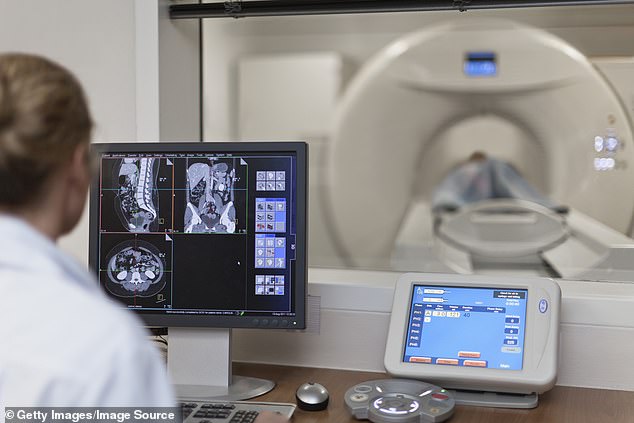Wisconsin woman shoots herself in the buttocks after sneaking a GUN to MRI appointment in bizarre case revealed by FDA
- Woman put her gun in the MRI room and it was attracted to the machine's magnet
- The FDA lists 102 reports of adverse events involving an MRI machine
- READ MORE: Kim Kardashian criticized for promoting a 'rip off' $2,500 MRI scan
A woman who tried to bring a gun to an MRI appointment suffered a gunshot wound to the buttocks after the machine caused the firearm to discharge.
The 57-year-old unnamed Wisconsin woman suffered a single bullet in her right buttock cheek when the firearm she was carrying came too close to the MRI machine.
The trigger may have been pulled due to the MRI's powerful magnet.

People may be prescribed an MRI for many reasons, including to detect tissue tears, tumors, spinal injury or disease, damage to internal organs, or brain conditions that do not show up on the traditional X-ray (stock photo)
The incident occurred in Waukesha, in the Milwaukee metropolitan area, in June 2023.
Her doctor reported it to the Food and Drug Administration's (FDA) Manufacturer and User Facility Device Experience (MAUDE) database about a month later.
Before entering the MRI room, the woman underwent a routine screening procedure in which she was asked if she was carrying any potentially dangerous items, including whether she was carrying a gun.
She answered no to all questions.
Patients undergoing an MRI are explicitly told to leave anything that could be attracted to the magnet out of the room, including piercings, jewelry, cell phones, metal on or in clothing, and weapons, including weapons.
People are even asked if they have tattoos and are warned that they may experience discomfort or irritation as some tattoo inks may contain metal that is attracted to the MRI magnet.
MRIs use strong magnets to obtain detailed images of the body's tissues, organs, and skeletal system. An MRI machine uses the magnet to produce a magnetic field and radio waves to take pictures of the inner workings of the body.
Even when the machine is not in use, the magnet is always active.
The 57-year-old suffered a minor injury after being shot and made a full recovery without complications. It is not known whether the woman had a permit for the firearm.
When undergoing an MRI, people are often asked to undress completely and wear a doctor's gown, but it is not known whether the woman was asked to do so or where she hides the weapon.
MAUDE is a voluntary reporting system for adverse events associated with medical devices.
After she was shot by her own weapon, a doctor examined the woman and saw entry and exit holes that were “very small and superficial,” the FDA report said.
The bullet had only penetrated the subcutaneous tissue – the deepest layer of the skin consisting mainly of fat cells and connective tissue where most body fat is stored.
The patient was taken to a hospital and later reported that the wound was healing well.
People may be prescribed an MRI for many reasons, including to detect tissue tears, tumors, spinal injury or disease, damage to internal organs, or brain disorders that cannot be seen on the traditional X-ray.
The machine can create detailed images of the entire body from almost any angle.
Soft tissue in the body contains water and the magnetic field used by the MRI acts on microscopic substances in soft tissue called protons. These now magnetized protons send a signal to the MRI and then a computer organizes the signals into images that doctors can view.
It was not known which part of the body the Wisconsin woman had scanned.
The FDA's MAUDE system contains 102 reports of adverse events involving an MRI machine or procedure. Complaints include burned or irritated skin, hearing problems and machines that do not work properly and catch fire.
An MRI machine makes repetitive loud noises, including loud clicking and beeping. MRIs can take anywhere from a few minutes to up to 1.5 hours, depending on the size and location of the body part being scanned. For these reasons, people undergoing the scan are usually provided with earplugs.
